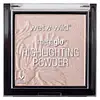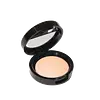What's inside
What's inside
 Key Ingredients
Key Ingredients

 Benefits
Benefits

 Concerns
Concerns

 Ingredients Side-by-side
Ingredients Side-by-side

Mica
Cosmetic ColorantSynthetic Fluorphlogopite
Dimethicone
EmollientBoron Nitride
AbsorbentOctyldodecyl Stearoyl Stearate
EmollientTrimethylsiloxysilicate
EmollientEthyl Macadamiate
Skin ConditioningPolysorbate 20
EmulsifyingPhytosteryl Macadamiate
Skin ConditioningCaprylic/Capric Triglyceride
MaskingPhenoxyethanol
PreservativeSorbitan Stearate
EmulsifyingTin Oxide
AbrasiveCaprylyl Glycol
EmollientMagnesium Aluminum Silicate
AbsorbentHexylene Glycol
EmulsifyingEthylhexylglycerin
Skin ConditioningWater
Skin ConditioningNylon-12
Silica
AbrasiveO-Cymen-5-Ol
AntimicrobialPolyacrylamide
Tocopheryl Acetate
AntioxidantC13-14 Isoparaffin
EmollientLaureth-7
EmulsifyingTriethoxycaprylylsilane
Tocopherol
AntioxidantLauroyl Lysine
Skin ConditioningCI 77891
Cosmetic ColorantCI 77491
Cosmetic ColorantCI 77492
Cosmetic ColorantCI 77499
Cosmetic ColorantMica, Synthetic Fluorphlogopite, Dimethicone, Boron Nitride, Octyldodecyl Stearoyl Stearate, Trimethylsiloxysilicate, Ethyl Macadamiate, Polysorbate 20, Phytosteryl Macadamiate, Caprylic/Capric Triglyceride, Phenoxyethanol, Sorbitan Stearate, Tin Oxide, Caprylyl Glycol, Magnesium Aluminum Silicate, Hexylene Glycol, Ethylhexylglycerin, Water, Nylon-12, Silica, O-Cymen-5-Ol, Polyacrylamide, Tocopheryl Acetate, C13-14 Isoparaffin, Laureth-7, Triethoxycaprylylsilane, Tocopherol, Lauroyl Lysine, CI 77891, CI 77491, CI 77492, CI 77499
Mica
Cosmetic ColorantTalc
AbrasiveNylon-12
Dimethicone
EmollientIsopropyl Palmitate
EmollientPolysorbate 20
EmulsifyingMagnesium Aluminum Silicate
AbsorbentPhenoxyethanol
PreservativeTocopheryl Acetate
AntioxidantCaprylyl Glycol
EmollientLauroyl Lysine
Skin ConditioningSodium Dehydroacetate
PreservativeSimmondsia Chinensis Seed Oil
EmollientCetearyl Ethylhexanoate
EmollientOctyldodecyl Stearoyl Stearate
EmollientSorbitan Stearate
EmulsifyingPropylene Glycol Dicaprylate/Dicaprate
EmollientHelianthus Annuus Seed Oil
EmollientHexylene Glycol
EmulsifyingAcrylamide/Sodium Acryloyldimethyltaurate Copolymer
Emulsion StabilisingWater
Skin ConditioningIsohexadecane
EmollientSynthetic Fluorphlogopite
Calcium Sodium Borosilicate
Centella Asiatica Extract
CleansingCalcium Aluminum Borosilicate
Polysorbate 80
EmulsifyingCamellia Sinensis Leaf Extract
AntimicrobialSorbitan Oleate
EmulsifyingSilica
AbrasiveTocopherol
AntioxidantCI 77891
Cosmetic ColorantIron Oxides
Mica, Talc, Nylon-12, Dimethicone, Isopropyl Palmitate, Polysorbate 20, Magnesium Aluminum Silicate, Phenoxyethanol, Tocopheryl Acetate, Caprylyl Glycol, Lauroyl Lysine, Sodium Dehydroacetate, Simmondsia Chinensis Seed Oil, Cetearyl Ethylhexanoate, Octyldodecyl Stearoyl Stearate, Sorbitan Stearate, Propylene Glycol Dicaprylate/Dicaprate, Helianthus Annuus Seed Oil, Hexylene Glycol, Acrylamide/Sodium Acryloyldimethyltaurate Copolymer, Water, Isohexadecane, Synthetic Fluorphlogopite, Calcium Sodium Borosilicate, Centella Asiatica Extract, Calcium Aluminum Borosilicate, Polysorbate 80, Camellia Sinensis Leaf Extract, Sorbitan Oleate, Silica, Tocopherol, CI 77891, Iron Oxides
 Reviews
Reviews

Ingredients Explained
These ingredients are found in both products.
Ingredients higher up in an ingredient list are typically present in a larger amount.
Caprylyl Glycol is a humectant and emollient, meaning it attracts and preserves moisture.
It is a common ingredient in many products, especially those designed to hydrate skin. The primary benefits are retaining moisture, skin softening, and promoting a healthy skin barrier.
Though Caprylyl Glycol is an alcohol derived from fatty acids, it is not the kind that can dry out skin.
This ingredient is also used as a preservative to extend the life of products. It has slight antimicrobial properties.
Learn more about Caprylyl GlycolCi 77891 is a white pigment from Titanium dioxide. It is naturally found in minerals such as rutile and ilmenite.
It's main function is to add a white color to cosmetics. It can also be mixed with other colors to create different shades.
Ci 77891 is commonly found in sunscreens due to its ability to block UV rays.
Learn more about CI 77891Dimethicone is a type of synthetic silicone created from natural materials such as quartz.
What it does:
Dimethicone comes in different viscosities:
Depending on the viscosity, dimethicone has different properties.
Ingredients lists don't always show which type is used, so we recommend reaching out to the brand if you have questions about the viscosity.
This ingredient is unlikely to cause irritation because it does not get absorbed into skin. However, people with silicone allergies should be careful about using this ingredient.
Note: Dimethicone may contribute to pilling. This is because it is not oil or water soluble, so pilling may occur when layered with products. When mixed with heavy oils in a formula, the outcome is also quite greasy.
Learn more about DimethiconeHexylene Glycol is a surfactant. Glycols are a class of alcohols. Hexylene Glycol is a surfactant and emulsifier.
As a surfactant, Hexylene Glycol helps gather dirt and oil on your skin to be washed away.
As an emulsifier, Hexylene Glycol helps keep water and oil together. This prevents them from separating in a product. Hexylene Glycol also thins out the texture of a product by lessening viscosity.
Hexylene Glycol has a small molecular weight.
Learn more about Hexylene GlycolThis ingredient comes from a fatty acid (lauric acid) and amino acid (lysine). It is used to add a silky feel to cosmetics.
According to a manufacturer, its fatty acid base leaves a silky feeling on the skin. It also has emollient properties because of this. Emollients help soften skin by preventing water from evaporating.
Lauroyl lysine is barely soluble in water.
Learn more about Lauroyl LysineMagnesium Aluminum Silicate is a type of silica. It comes from naturally occuring minerals such as silicate ores and clay.
Magnesium aluminum silicate is used for enhancing texture and as an absorbent. Due to its large molecular size, it is unable to be absorbed into the skin.
Like other types of silica, this ingredient can be used to thicken a product. As an absorbent, it may be used to absorb extra water or help prevent clumping.
Although “aluminum” in an ingredient name can raise red flags for some consumers, the form and usage context matter significantly. For typical topical applications, there is no substantial evidence of health risks - such as cancer, neurotoxicity, or systemic “aluminum overload.”
Learn more about Magnesium Aluminum SilicateMica is a naturally occurring mineral used to add shimmer and color in cosmetics. It can also help improve the texture of a product or give it an opaque, white/silver color.
Serecite is the name for very fine but ragged grains of mica.
This ingredient is often coated with metal oxides like titanium dioxide. Trace amounts of heavy metals may be found in mica, but these metals are not harmful in our personal products.
Mica has been used since prehistoric times throughout the world. Ancient Egyptian, Indian, Greek, Roman, Aztec, and Chinese civilizations have used mica.
Learn more about MicaNylon-12 is a polymer. It is derived from 12-aminododecanoic acid, an omega-amino fatty acid
According to a manufacturer, it is a talc substitute. Like talc, nylon-12 gives products a satin feel. The manufacturer also claims this ingredients does not block pores and has moderate oil absorption.
This ingredient may not be reef-safe.
Learn more about Nylon-12Octyldodecyl Stearoyl Stearate is created from stearic acid.
It is an emollient and thickens the lipid (oil) portion of a product. Due to its emollient properties, it may not be fungal-acne safe.
Phenoxyethanol is a preservative that has germicide, antimicrobial, and aromatic properties. Studies show that phenoxyethanol can prevent microbial growth. By itself, it has a scent that is similar to that of a rose.
It's often used in formulations along with Caprylyl Glycol to preserve the shelf life of products.
Polysorbate 20 is made by combining ethoxylation of sorbitan, ethylene oxide, and lauric acid. It is a mild cleansing agent, surfactant, and emulsifier.
As a surfactant, it helps collect dirt and oils for washing. Emulsifiers prevent oils and water from separating.
Polysorbate 20 also adds scent to a product. Since it is made using sorbitol, it has a sweet scent. Sorbitol can also be found in fruits such as apples and peaches.
The lauric acid used to create Polysorbate 20 is often derived from coconuts.
Polysorbate 20 may not be fungal acne safe.
Learn more about Polysorbate 20Silica, also known as silicon dioxide, is a naturally occurring mineral. It is used as a fine, spherical, and porous powder in cosmetics.
Though it has exfoliant properties, the function of silica varies depending on the product.
The unique structure of silica enhances the spreadability and adds smoothness, making it a great texture enhancer.
It is also used as an active carrier, emulsifier, and mattifier due to its ability to absorb excess oil.
In some products, tiny microneedles called spicules are made from silica or hydrolyzed sponge. When you rub them in, they lightly polish away dead skin layers and enhance the penetration of active ingredients.
Learn more about SilicaSorbitan Stearate comes from sorbitol and stearic acid. Sorbitol is a type of sugar and stearic acid is a fatty acid.
It is used as an emulsifier and helps ingredients stay together by creating water-in-oil emulsions.
This ingredient may not be Malassezia folliculitis, or fungal-acne safe.
Synthetic Fluorphlogopite is the synthethic version of mica. It consists of fluorine, aluminum and silicate.
Synthetic Fluorphlogopite is used to add volume to products.
It is considered non-irritating on the skin.
Learn more about Synthetic FluorphlogopiteTocopherol (also known as Vitamin E) is a common antioxidant used to help protect the skin from free-radicals and strengthen the skin barrier. It's also fat soluble - this means our skin is great at absorbing it.
Vitamin E also helps keep your natural skin lipids healthy. Your lipid skin barrier naturally consists of lipids, ceramides, and fatty acids. Vitamin E offers extra protection for your skin’s lipid barrier, keeping your skin healthy and nourished.
Another benefit is a bit of UV protection. Vitamin E helps reduce the damage caused by UVB rays. (It should not replace your sunscreen). Combining it with Vitamin C can decrease sunburned cells and hyperpigmentation after UV exposure.
You might have noticed Vitamin E + C often paired together. This is because it is great at stabilizing Vitamin C. Using the two together helps increase the effectiveness of both ingredients.
There are often claims that Vitamin E can reduce/prevent scarring, but these claims haven't been confirmed by scientific research.
Learn more about TocopherolTocopheryl Acetate is AKA Vitamin E. It is an antioxidant and protects your skin from free radicals. Free radicals damage the skin by breaking down collagen.
One study found using Tocopheryl Acetate with Vitamin C decreased the number of sunburned cells.
Tocopheryl Acetate is commonly found in both skincare and dietary supplements.
Learn more about Tocopheryl AcetateWater. It's the most common cosmetic ingredient of all. You'll usually see it at the top of ingredient lists, meaning that it makes up the largest part of the product.
So why is it so popular? Water most often acts as a solvent - this means that it helps dissolve other ingredients into the formulation.
You'll also recognize water as that liquid we all need to stay alive. If you see this, drink a glass of water. Stay hydrated!
Learn more about Water